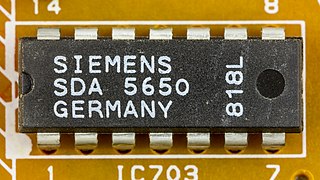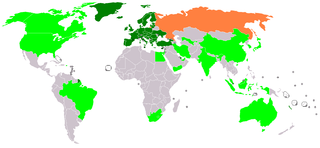Related Research Articles

The European Conference of Postal and Telecommunications Administrations (CEPT) was established on June 26, 1959, by nineteen European states in Montreux, Switzerland, as a coordinating body for European state telecommunications and postal organizations. The acronym comes from the French version of its name Conférence européenne des administrations des postes et des télécommunications.

Digital Enhanced Cordless Telecommunications (DECT) is a cordless telephony standard maintained by ETSI. It originated in Europe, where it is the common standard, replacing earlier standards, such as CT1 and CT2. Since the DECT-2020 standard onwards, it also includes IoT communication.
Digital Access Signalling System 2 (DASS2) is an obsolescent protocol defined by British Telecom for digital links to PSTN based on ISDN. Although still available on request, it has been superseded by ETS 300 102 ("EuroISDN").
QSIG is an ISDN based signaling protocol for signaling between private branch exchanges (PBXs) in a private integrated services network (PISN). It makes use of the connection-level Q.931 protocol and the application-level ROSE protocol. ISDN "proper" functions as the physical link layer.

Videotex was one of the earliest implementations of an end-user information system. From the late 1970s to early 2010s, it was used to deliver information to a user in computer-like format, typically to be displayed on a television or a dumb terminal.
ISO/IEC 646 is a set of ISO/IEC standards, described as Information technology — ISO 7-bit coded character set for information interchange and developed in cooperation with ASCII at least since 1964. Since its first edition in 1967 it has specified a 7-bit character code from which several national standards are derived.

Programme delivery control (PDC) is specified by the standard ETS 300 231, published by the European Telecommunications Standards Institute (ETSI). This specifies the signals sent as hidden codes in the teletext service, indicating when transmission of a programme starts and finishes.

Bildschirmtext was an online videotex system launched in West Germany in 1983 by the Deutsche Bundespost, the (West) German postal service.

Prestel, the brand name for the UK Post Office Telecommunications's Viewdata technology, was an interactive videotex system developed during the late 1970s and commercially launched in 1979. It achieved a maximum of 90,000 subscribers in the UK and was eventually sold by BT in 1994.
Enhanced Full Rate or EFR or GSM-EFR or GSM 06.60 is a speech coding standard that was developed in order to improve the quality of GSM.
CEPT may refer to:
T.51 / ISO/IEC 6937:2001, Information technology — Coded graphic character set for text communication — Latin alphabet, is a multibyte extension of ASCII, or more precisely ISO/IEC 646-IRV. It was developed in common with ITU-T for telematic services under the name of T.51, and first became an ISO standard in 1983. Certain byte codes are used as lead bytes for letters with diacritics (accents). The value of the lead byte often indicates which diacritic that the letter has, and the follow byte then has the ASCII-value for the letter that the diacritic is on.

World System Teletext (WST) is the name of a standard for encoding and displaying teletext information, which is used as the standard for teletext throughout Europe today. It was adopted into the international standard CCIR 653 of 1986 as CCIR Teletext System B.
YUSCII is an informal name for several JUS standards for 7-bit character encoding. These include:
XAdES is a set of extensions to XML-DSig recommendation making it suitable for advanced electronic signatures. W3C and ETSI maintain and update XAdES together.

The European Telecommunications Standards Institute (ETSI) is an independent, not-for-profit, standardization organization operating in the field of information and communications. ETSI supports the development and testing of global technical standards for ICT-enabled systems, applications and services.
CAdES is a set of extensions to Cryptographic Message Syntax (CMS) signed data making it suitable for advanced electronic signatures.
Singapore Teleview or known as Camp-Camp View or Ke Pik was a Singaporean videotext service. In the mid 1980s, the Telecom Authority of Singapore entered into a joint venture development with GEC Marconi in the UK to develop a photo-videotext public service. Selected engineers were sent to the UK to work within the Marconi development team stationed at Fleet, Hampshire, England. Singapore was the first country in the world to launch an interactive information service to the public which included photographic images. The service started trials during late 1987 using specifically designed terminals. Controlled trials had been conducted since 1987 as the infrastructure was installed and trialed successfully. It finally went into full public service in 1991.
This article covers technical details of the character encoding system defined by ETS 300 706 of the ETSI, a standard for World System Teletext, and used for the Viewdata and Teletext variants of Videotex in Europe.

The character sets used by Videotex are based, to greater or lesser extents, on ISO/IEC 2022. Three Data Syntax systems are defined by ITU T.101, corresponding to the Videotex systems of different countries.
